

(Louis Meulstee’s web site)
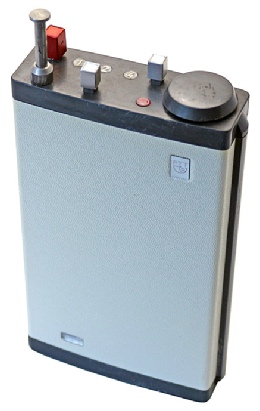
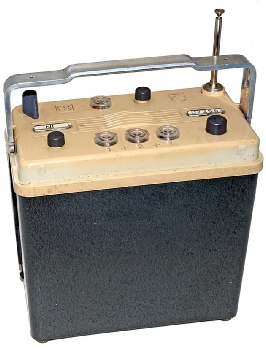
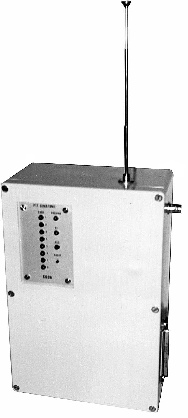
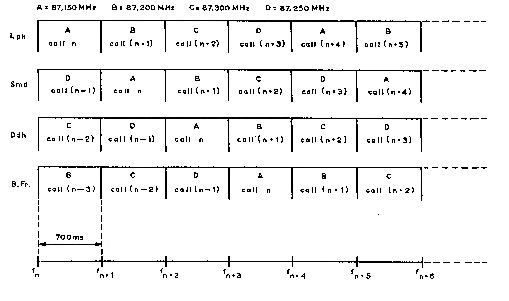

SEMAFOON
SEMAFOON (Paging) IN THE NETHERLANDS
A short historical survey of radio developments at PTT (KPN Telecom)
By Louis Meulstee, PA0PCR, retired KPN Telecom.




Disclaimer: The contents of these pages are not official KPN Telecom material. They primarily consist of privately collected information about the history of the 'Mobilofoon' department, where I was employed until my retirement. For official information, please refer to the KPN website at www.kpn.com.
EARLY EXPERIMENTS
As explained in a previous article 1), soon after the opening of the National Public Radiotelephone Network in 1949, the need was felt for a selective radio paging system to call a mobile station.
It was indicated, however, that a paging receiver should not be a part of the mobile radio-telephone system which, at that time, was being used in other countries.
In 1955, the first trials with mobile paging receivers started with commercially manufactured Swiss Hassler ‘Autorűf’ (car paging) equipment, adapted especially for the PTT. Due to their weight and battery drain, the receivers could only be operated from a vehicle battery. A total of seventeen receivers were fitted into vehicles of potential customers, such as general-practitioner medical doctors, a veterinary surgeon, an ambulance, public transport, an emergency-breakdown service vehicle, a television service car, and a number of PTT vans and vehicles.
The Hasler paging receivers were superheterodynes operating on 85.9 MHz. The amplitude-modulated transmitter, being a part of the complete system by Hasler, was located at the PTT laboratory near The Hague. Requests for calls or urgent calls were made via a telephone operator. A call comprised three different tones transmitted sequentially and repeated three times. After extensive trials, it became apparent that a nationwide paging service should not only include the mobile radio-telephone service but should be set up as an independent service. It was anticipated that hand-held or portable paging receivers would be in future demand.
SIMOFOON
The trial system was called SIMOFOON, derived from SIgnaling to a MObiloFOON. The latter, MOBILOFOON (sometimes called MOBILIPHONE), was a name devised by the Dutch PTT in the late forties as a translation from the English name Mobile Radio-telephone. In the early days of the trial system, our veterinary surgeon paid a routine visit to ‘Duindigt’, a large race-course near The Hague, to carry out an examination of a race horse. When he finished and was about to climb into his car, the Hasler paging receiver suddenly indicated a red emergency call. Still at the stables, he telephoned his home and heard about an accident with a race horse at an adjoining stable that urgently needed his attention. Turning the car and driving only 450 meters took only seconds. On arrival, he found the stable locked. In a few minutes, the groom arrived. He had to walk to a nearby telephone to report the emergency and
SUMMARY
A Brief History of the National Public Radio Paging Service: Semafoon.
This survey provides a historical account of the national public radio paging service, focusing on the early developments at the Dutch PTT from the 1950s to the start of the digital era. Throughout this survey, the old name 'PTT' is used as it predominantly covers the period before the company's privatization and subsequent renaming to KPN.
The Semafoon service, inaugurated in 1964, was a fully-automatic, individual, public paging system accessible to any telephone subscriber, marking the world's first of its kind with nationwide coverage. Within a few years of its launch, the coverage expanded to include Belgium and later Luxembourg.
In the early 1960s, the Dutch PTT Dr. Neher laboratory developed the Early Central Control System (CCS), which underwent continuous expansion and modernization. However, the Semafoon System 3, operational since 1988 (and closed in November 2005), differed significantly from the initial and second systems. Notably, it now offers provisions for numerical and alphanumeric paging while maintaining full operational status and Benelux coverage. Over the years, the physical size of the paging receivers has significantly reduced from 4500 grams to 200 grams. Pagers operating on the Semafoon 3 system came with a wide range of optional features, making them even lighter and smaller in size.
This survey was originally written in 1992. As many major changes occurred within the company in the following years, some statements are now outdated. However, I did not alter the original text as it only covers the period up to the 1990s. In this website-based revision, a number of additions have been made, along with more information on the Semafoon 3 system and the Greenpoint Semaphone version
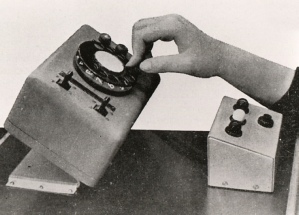
INTRODUCTION
The Semafoon was a radio paging service that enabled any telephone subscriber to make a selective call to any portable paging receiver located anywhere within the Benelux countries. The system comprised a Central Control System (CCS) and a number of high-power VHF transmitters. The input of the CCS was linked to the national telephone networks, and its output was connected to the transmitter sites, which were located throughout the Benelux. A Semafoon call, dialled by a telephone subscriber, was stored and processed by the CCS and forwarded to the transmitters. On the pager, a beep indicated that a call was being received. The last dialled digit, providing a user pre-arranged message, was indicated on the Semafoon by one or more lamps or on a display in later models. Highly technical details were considered to be out of the scope of this paper, as they had been described in minute detail in other papers.
Operator console and control system of the modified Swiss Hasler paging system (left and below).
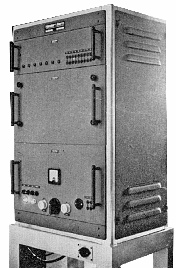
Hasler Paging System as used with early experiments in 1955. The system worked basically with three different sub-audible tones transmitted sequentially and repeated three times. Tuned reeds in the receiver were utilized as selective tone receivers. In addition to the standard white calling lamp, a PTT modification included the fitting of a second (red) lamp
Receiver remote control unit.
The actual receiver was installed in the back of the customer’s vehicle.
which, when activated by the operator, indicated an emergency call. The receiver had two RF stages, a mixer with a crystal-controlled oscillator, and in order to reduce battery consumption, it had a superregenerative detector operating on the intermediate frequency of 10.7 MHz. During the early Dutch experiments, the system operated on 85.9 MHz. The power consumption at 6 volts was approximately 18 watts.
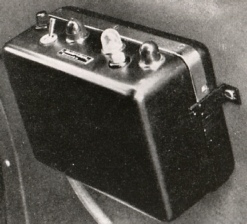

The experimental Swiss Hassler system
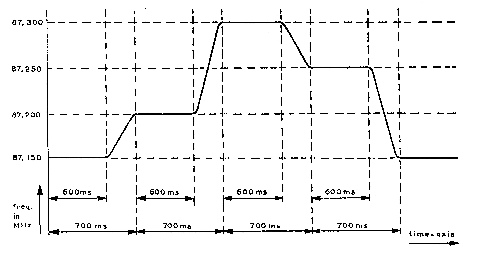
found to his astonishment that, upon his return, the surgeon was already waiting at the stable, knowing all about the situation. (One should remember that in the mid-50’s, the marvels of radio were generally unknown to the public.)
SEMAFOON 1 (1964-1978)
One of the major conclusions of the trials was that a huge number of subscribers could be expected, requiring a large capacity, and more particularly, a large traffic capacity. This led to the formation of a fully-automatic service. Specifications for pagers and the Central Control System were set up in the late 1950s in cooperation with the PTT Laboratories and Philips Telecommunication Industries (PTI). In 1961, the new service was officially cleared to go ahead, and orders were placed for the development and manufacturing of a CCS at the PTT laboratories, and for paging receivers at Philips. Over the next two years, the system was tested and gradually improved until satisfactory results were obtained. The service was inaugurated on 24th September 1964, initially with three transmitters providing coverage in the Netherlands only.
It was decided to continue with the already generally-accepted name SIMOFOON. However, as a result of anticipated legal action from a certain manufacturer whose product name had a close resemblance to the name SIMOFOON, it was altered into SEMAFOON from the Greek SEMA = Signal, and FONEIN = Calling. Eventually, it was considered that this was an even better name for the new public radio-paging service.
Diagram 2. Shifting Cycle Principle.
Explanation of the shifting cycle principle of one transmitter group only. A frequency shift of more than 100 kHz was avoided as a precaution against unwanted radiated products.
Condensed Technical Details
Transmitter Network:
The system operated on two (later four) RF channels around 87 MHz, just below the FM broadcast band. This allowed the use of high power and standard FM broadcast transmitters. Previous investigations showed a preference for FM or PM over AM. Existing radiotelephone components, such as RF low-power drivers and phase modulators driving standard FM broadcast transmitters, were utilized. Initially, three transmitter sites were installed, which were later expanded with sites in Belgium, along with several auxiliary low-power transmitters.
RF Switching:
To prevent interference and avoid channel switches in the paging receiver, a frequency-shift system was devised. Two frequencies (later expanded to four) were assigned, resulting in two (four) pager versions, each identical except in frequency.
Diagram 1 shows a call being repeated four times on one frequency in a fixed order by the four principal transmitters. Each transmitter shifted in frequency every 700 milliseconds. Steps of more than a 100 kHz shift were avoided to prevent possible interference radiation.
Diagram 2 illustrates the shifting principle for one transmitter.
Capacity.
Trials with sequential and simultaneous transmission of calls pointed favourably towards a sequential system. In the selective call system, a series of thirty audio frequency tones ranging between 1,000 Hz and 6,000 Hz were used. Three tones, each with a duration of 100 milliseconds, were transmitted in succession, providing about 24,360 combinations. With four RF channels, each having 24,360 combinations, the network had a theoretical capacity of 97,440 users. However, it was limited by the duration of the call, which was repeated after approximately 20 seconds, and given an average number of 0.5 calls per user per day, the traffic capacity of the system was calculated to be about 51,420 users. Additionally, besides individual calls, a group call to a number of paging receivers could be made.
Diagram 1. Operation of the Semafoon Network Transmitters.
Showing how a call is transmitted on one frequency by four transmitter groups. Four frequencies were assigned: 87.150, 87.200, 87.250, and 87.300 kHz.
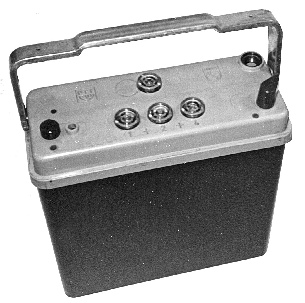
ESCORT PAGING RECEIVERS
In the late 1950s, with the advent of suitable RF transistors, it became possible to develop fully transistorised paging receivers. The first receivers of this kind were in operational use by the Dutch PTT in 1959 with the opening of the local Simofoon system in East Flevoland. Experience with these still rather bulky and crude receivers formed the base for the more compact ESCORT Semafoon.
A prototype became available for trials in the early 1960s, and full-scale production began in 1963. The ESCORT Semafoon served for 26 years because many customers had a fixed installation aboard a vessel or in a vehicle and, consequently, were very slow to exchange their receivers in the early 1980s.
An interesting feature of the ESCORT was its optional relay function, providing a customer-usable contact activated by the call.
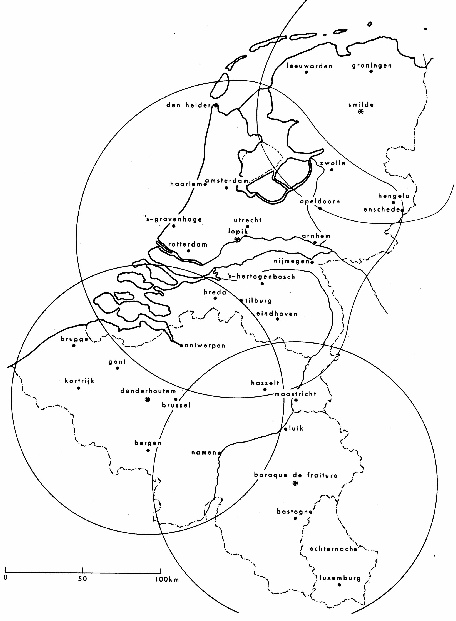
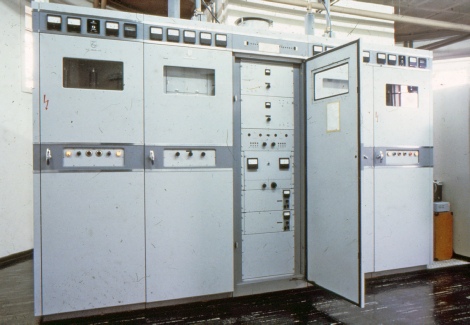
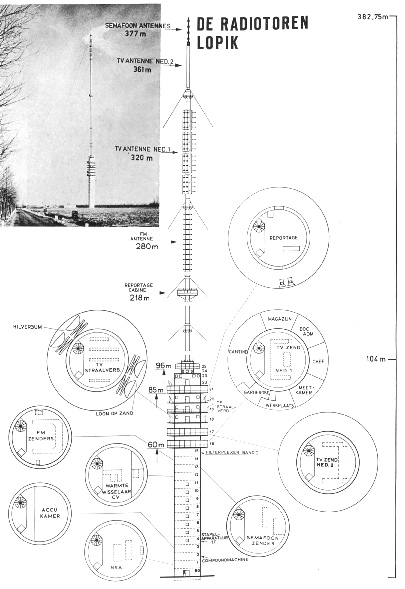
Semafoon transmitter: driver stages in the centre and RF power stages left and right.
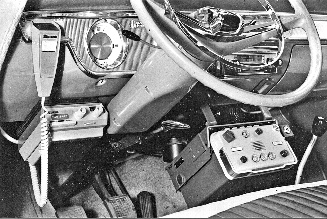
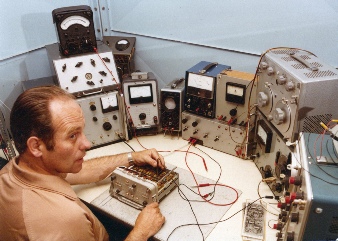
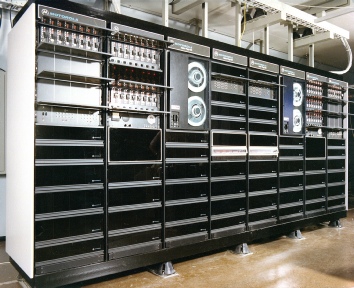
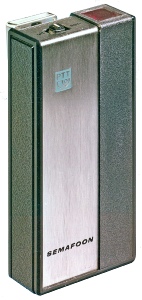
BENELUX COVERAGE
In 1966, the transmitter network was expanded with two transmitters in Belgium: Denderhouten in the west, and Baraque de Fraiture, providing coverage in the south and east of Belgium. The Dutch transmitter in the south was then used only in emergencies since it was found that one of the Belgian transmitters would give adequate coverage of that particular area. Although the participation with Belgium was agreed upon in 1964, the Belgian service was inaugurated only on 14th February 1967.
In 1980, the Luxembourg PTT joined the Semafoon system. The transmitter network of the Belgian part of the Semafoon system was serviced by the Dutch PTT. The Belgian site of Baraque de Fraiture was invariably and intimately called ‘Baraque de Friture’ by our technicians, as a pun on the Belgians who are famous for their French-fried potatoes, usually sold along the streets in so-called 'fritures'.
Prototype ESCORT Semafoon(1963).
REFERENCES and further reading:
- Technical Handbook Autorufempfänger, Hasler AG, Bern, 1954.
- Autoruf-Anlage für 60 Fahrzeuge mit Notalarm, Hasler AG, Bern, 1954.
- 'Simofoon codegever Type 8RE 510/000, Beschrijving DB-R750, Philips Telecommunication Industries, Holland, 1959.
- 'Simofoon ontvanger Type 8RO 529/000, Beschrijving DB-R754, Philips Telecommunication Industries, Holland, 1959.
- 'Simofoon, Proeven met 'Signalerende Mobilofoon', PTT Bedrijfsbanden August 1956, Vol. 17, No. 8, pp 237 - 238.
- G.M. Uitermark, Een nieuwe dienstverlening van PTT: De Simofoon, Weekblad 'De ingenieur', No. 52, 1961.
- 'Semafoon Type ESC, 8MO 520/101', Beschrijving DB-R1652n, Philips Telecommunication Industries, Holland, 1963.
- G.M. Uitermark, ‘The Simofoon, A New Service of the Dutch PTT’, The Wireless World, January 1963, pp2-9.
- F.J.J. van der Put, 'Semafonie', Data, orgaan van de Vereniging van technisch Hoger Personeel der PTT, 69s jaargang,
1968, Nr. 2, pp 17-40.
- 'Semafoons ter grootte pocketboek', Aangetekend, Personeelskrant PTT, 1 Sept. 1971, Jrg. 4, No. 17.
- F.J.J. van der Put, 'Semafoon, A Radio Paging System', unpublished English translation of PTT Telecom brochure, 1972.
- Historisch overzicht Semafoondienst mei 1952-mei 1972, Internal PTT document, HP vd Bosch.
- Historisch overzicht Semafoondienst 1972-1988, Iternal PTT document, WA van Engelen.
- History of the Public Telephone System in the Netherlands 1881 - 1997, PTT 1981, pp 210 -211.
- Schakelschema Type Coda, CD PTT, MBF 5000/2/05, mei 1982.
- D. Fokkenrood, 'Het Benelux Semafoon Systeem', CD PTT, 2nd ed., MBF 5000/02/03, januari 1985.
- 'In twee minuten gevonden', Telescope No. 2, PTT Telecommunicatie brochure, n.d.
- ‘Even oppiepen’, Venster van de Telecommunicatie, www.telecomerfgoed.nl
- Gebruiksaanwijzing Semafoonontvanger, PTT, Td 147, n.d.
- Instructiekaart ESCORT Semafoon, PTT, Td 148, n.d.
- ESC Semafoon gebruiksaanwijzing, MBF-5120/05/01, nov. 1978.
- MNR SEMAFOON, Gebruiksaanwijzing, PTT, n.d.
- PICCOLO, Gebruiksaanwijzing, MBF-5400/05/01, mei 1981.
- KOLIBRIE, Gebruiksaanwijzing, MBF-5600/05/01. n.d.
- GREENHOPPER 500s handset, Gebruiksaanwijzing. n.d.
This article was published in a slightly different form as 'Radio Paging in the Netherlands' by L. Meulstee in ‘Proceedings
of the Radio Club of America, Vol. 66, No. 3, Nov. 1992, pp 56-64’.
The view of the Semafoon transmitter location at Lopik showed the aerial at 377m on top, while the actual transmitter was installed on the 13th floor.
ESCORT Semafoon (1964-1990).
SEMAFOON SYSTEM 2: DIGITAL BREAKTHROUGH (1978-1990)
In the 1970s, it became necessary to expand the number and traffic capacity of the system. Until then, no particular steps had been taken to attract potential customers for the service, given the anticipated huge demands.
Replacing the Initial Central Control System.
Because the initial CCS could not be easily expanded, both the CCS and transmitter driver stages were replaced in 1978 with a commercially-marketed digital system (Motorola Metro Pager 100). This system had a special adaptation for PTT to permit the use of the older analogue pagers on the system. The new CCS allowed for the allocation of up to 200,000 subscribers. It could handle both analogue for the ESCORT and MINOR, and digital signals for the PICCOLO Semafoon.
The Motorola Metro-Page-100 CCS, as used with SEMAFOON-2, underwent a modification that still allowed the use of the older Escort and Minor Semafoons. (1978-1990)
RF BLACK SPOTS
When the MINOR Semafoon was introduced, a number of RF 'black spots' were reported in several areas. This problem resulted from the MINOR's reduced aerial length and became more serious with the introduction of the PICCOLO Semafoon, which had a much smaller and less effective aerial. To solve this issue, a number of auxiliary low-power transmitters were installed throughout the Benelux countries.
CODA
In the early 1980s, the ESCORT Semafoon was scheduled to be abandoned due to its age. However, it was claimed that its optional relay function, not available on the MINOR and PICCOLO, should continue to be accessible to the public.
In May 1982, PICCOLO Semafoons were modified by the PTT. The new Semafoon was named CODA and provided a connector with eight contacts corresponding to the code indicated on the display. However, some customers were very slow in exchanging their Semafoons, and the ESCORT remained in use for this purpose until the shutdown of the Semafoon 2 CCS on 2 July 1990. It is noteworthy that the transmitters remained in idle operation until 30 January 1991.
PICCOLO Semafoon (1978 - 1990)
Based on the Motorola Metro Pager, this pager was custom-developed exclusively for the Dutch PTT. It provided a selection of eight different codes. The aerial was a loop primarily made of the metal cover; however, it was not very effective and needed approximately 20 dB more field-strength than the ESCORT Semafoon.
KOLIBRIE REGIONAL SEMAFOON
In 1975, a public regional Semafoon service was inaugurated in the Amsterdam area, using Martin Marietta pagers. Although it had regional coverage and only two codes, this system was considered very successful. As a result, in 1980, a second regional Semafoon system (Motorola Metro Page) was opened in the Rotterdam region and later expanded to the Rijnmond area.
The independently-operating regional stand-alone Semafoon systems, operating in the 160MHz band, provided some relief to the continuously growing demand for national pagers and the nearly fully-occupied capacity of the National Semafoon-2 System.
SEMAFOON SYSTEM 3 (1988-2005)
Although this historical survey was originally based only on the early Semafoon 1 and 2 systems, in this later version, details of Semafoon 3 were added. The capacity of Semafoon 2 proved insufficient due to the ever-increasing demand, and during the early 1980s, with further expansion of the existing National Semafoon System inevitable, research was directed towards the Semafoon 3 system that could accommodate sufficient capacity to meet future public demands. Since high-power transmitters operating in the 4-meter band could no longer be continued, a different system had to be selected. Eventually, a Central Control System with Pocsag coding, manufactured by NEC, was chosen, while the transmitters (at over 130 sites) were developed in the Netherlands in close cooperation with the PTT. On 31st March 1988, Semafoon 3 system was officially inaugurated. A wide range of paging receivers, made by several manufacturers, was used. As explained in the earlier article, prior to the privatization of PTT Telecom, Semafoon paging receivers could only be leased from the PTT. Later, paging receivers were offered for lease and for sale, with an additional monthly network fee being charged. Semafoon 3 was in use until 5th November 2005.
Semafoon 3 operated on POCSAG, an asynchronous protocol used to transmit data to pagers. Its usual designation was an acronym of the Post Office Code Standardisation Advisory Group, the name of the group that developed the code under the chairmanship of the British Post Office.
The repairs of both the Escort and Minor Semafoons were executed at the Dutch PTT Central Workshop in The Hague, inside a Faraday cage, to prevent interference from the Semafoon transmitter in Lopik.
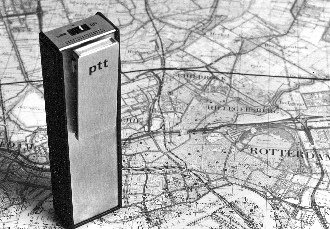
CODA Semafoon (1982 - 1990)
The CODA was basically a PICCOLO Semafoon connected to a PTT developed circuit decoding the digital readout into memory to provide eight customer-usable, voltage-free contacts. Only one contact, viz. the last received code, was active at the time.
PICCOLO SEMAFOON
At that time, no digital pagers operating in the 4-meter band were available. Therefore, it was decided to adapt the Motorola Metro Pager for the Dutch PTT, which led to a complete redesign. The new pager, named PICCOLO, was not only required to work on 4 meters but also to be able to select 8 code digits. Additionally, since it was evident that the capacity of the existing battery was too small, the pager was adapted to operate on a single penlight battery. A call was indicated by a beep, and the code-digit readout was shown by a 7-segment LED display on the top of the pager.
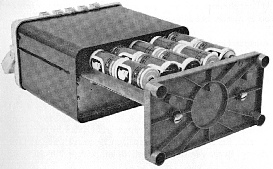
The ESCORT Semafoon was powered by 10 or optionally 5 ‘D’ dry batteries.

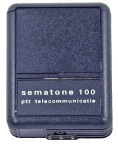
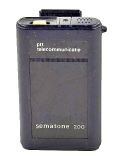
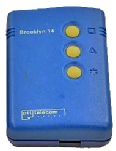
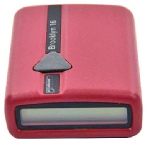
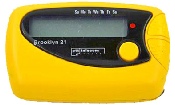
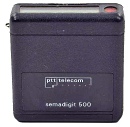
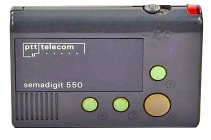
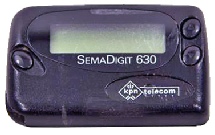
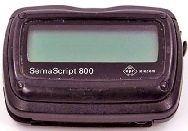
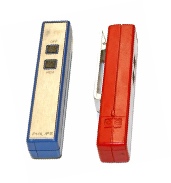
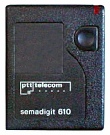
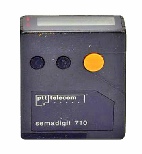
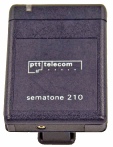
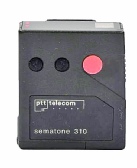

.jpg)
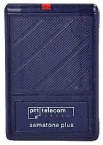
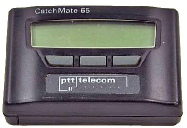
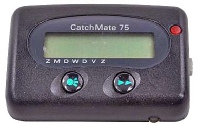
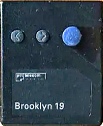
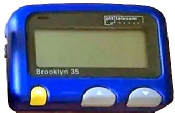
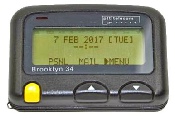
Sematone 100
Semadigit 500
Sematone 200
Semadigit 550
Brooklyn 14
Brooklyn 35
Brooklyn 16
Semascript 800
Sematone 210
Semadigit 610
Sematone 300
Semadigit 630
Brooklyn 17
Catchmate 65
Brooklyn 19
Catchmate 75
Sematone 310
Semadigit 710
Sematone plus
Brooklyn 21
Brooklyn 34
Sematone 410

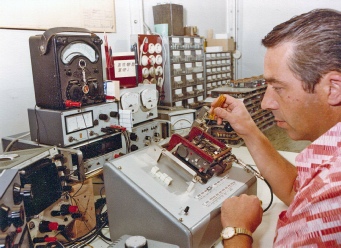
It was tempting to add a selection of the large variety of pagers marketed by PTT Telecom, featuring both low- and high-end lines. These pagers were all re-branded commercial models from various manufacturers. Notable omissions from this illustrated list include the Sematone 250, Sematone IS 1, Infoscript 1000, Semascript 900, Semascript 950, and probably more. The replacement for the ‘Coda’ was the Semaswitch, which had an RS-232 port for connecting various types of equipment.
- The Sematone line had no display (apart from the Sematone Plus) and consisted of tone-only reception models.
- The Semadigit series had a display and numeric reception, while the Semascript had an alphanumeric display.
- As for the later Brooklyn and Catch Mate series, there is currently not much information available; they were probably commercial
models with additional functionality.
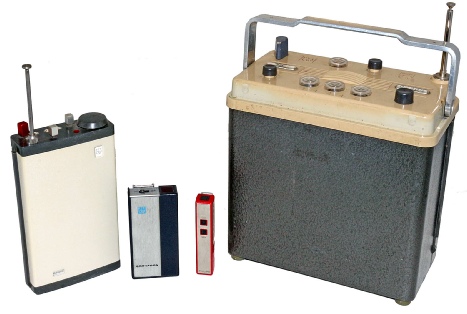
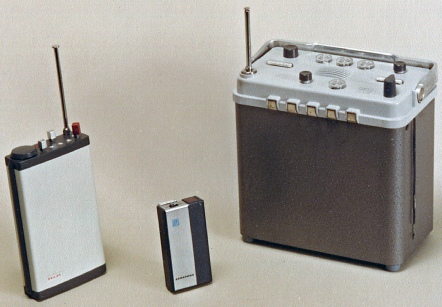
MINOR SEMAFOON
MINOR SEMAFOON
In August 1971, a new paging receiver was introduced: the MINOR Semafoon. It was developed in close cooperation with Philips Telecommunication Industries and was equipped with a rechargeable NiCad battery, providing approximately eight hours of operation on a fully charged battery. Thanks to thin-film technology and general advances in manufacturing, its weight was reduced to one-sixth of the initial ESCORT Semafoon, while its size was reduced to that of a pocket-sized paperback book. Essentially, the MINOR operated similarly to the ESCORT, with the main difference being in the layout and operation of the controls. An incoming call was signalled by a beep, and, to reduce current consumption, the displayed digit code was presented only when pressing a ‘readout’ button. The readout of the code digits was still done by one or two miniature lamps indicating the digits 1 + 2 + 4, providing an indication of six different user pre-arranged messages.
The iconic photograph taken at the introduction of the Piccolo in 1978 (left) was retaken 45 years later with the addition of a Sematone 300 pager (right). Even smaller pagers were produced by the trade, operating on the Pocsag protocol, but as far as is known, they were never marketed by PTT Telecom.
Greenpoint was a mobile phone network operated by PTT Telecom, now known as KPN, in the Netherlands. It was launched in May 1992 and was intended as a cheaper alternative to the expensive car phone network. The phone used in the Greenpoint network was called the Greenhopper. Initially, it was named 'Kermit', after the Muppet character Kermit the Frog. However, the licensing costs from Henson (the company that owns the Muppets) turned out to be too high, making an extension of the name "Kermit" unfeasible, and it was subsequently discontinued. Greenpoint was a Cordless Telephone Type 2 (CT2) system, based on the ETSI standard I-ETS 300 131. It operated digitally and working in the frequency range of 864.1 - 868.1 MHz.
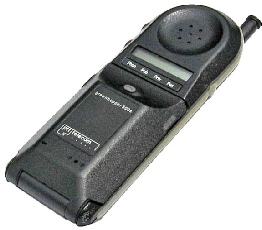
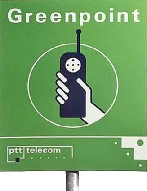
Greenhopper 500s had a built-in Semafoon 3.
Greenpoint (1992-1999)

The system had two types of usage: private and public. Private use involved a portable phone and a base station at home, which were connected to the telephone network. The public phone service worked in the immediate vicinity (150 meters away) of a public base station called a 'Telepoint.' In the Netherlands, there were around 5000 of these Telepoints, mainly located at post offices, V&D stores, gas stations, trade fair buildings, railway stations, restaurants, and parking lots. At these Greenpoint station locations, people could make outgoing calls but could not receive incoming calls. To remain reachable, users often used Semafoons. In 1993, the Greenhopper 500s were introduced, a wireless telephone with a built-in (numeric) Semafoon 3, allowing the user to be reachable via the Semafoon network in a cost-effective way. At its peak in 1996, Greenpoint had 60,000 subscribers, but by 1998, the number had declined to approximately 20,000. Greenpoint was overshadowed by GSM (and DECT), and on January 1, 1999, the system was closed.
TELEPOINT signpost
Epilogue
Very soon after the start of the first Hasler experiments, it became evident that a future nationwide paging system would experience significant expansion. Therefore, further development was directed towards a fully-automatic system. The decision to use the low end of the FM broadcast band allowed the utilization of commercially-available standard broadcast transmitters. Although the initial CCS was developed by the PTT Laboratories, and the early Semafoon receivers were exclusively for the PTT, it became clear that later developments of commercially-marketed systems, like the later Semafoon 3, would be more practical to implement in the future.
Over the years, the Semafoon system has proven to be a technical and commercial success. The parallel developments between the National Public Radiotelephone Network and the Semafoon systems 1 and 2 are remarkable. After conspicuous initial success, both services were expanded with independently-operating Regional Networks. Additionally, both services were claimed to be the world's first to have nationwide coverage.
LAND RECLAIM
After the first successful trials in The Hague, the Hasler equipment was later used as a temporary paging network covering East Flevoland, a vast area reclaimed from the sea while the reclamation process was still ongoing. During this stage, neither lines nor cables could be laid on the freshly reclaimed land, so all communications of the state agriculture department officials were conducted through a closed-network radio telephone system.
In 1959, a new paging system was installed in the East Flevoland area, replacing the Hasler system. Made by Philips Telecommunication Industrie in Hilversum, this system had a capacity of 89 users and operated in the 80MHz band using phase modulation. The code unit was a type 8RO 529/00, consisting of two similar units, one operational and one spare. The tone code consisted of two different tones of equal length, which were transmitted sequentially one after another. The transmitter was a standard 80 MHz type SRR 296 sender unit, of which two (one operational and one reserve) were placed in an SFZ 296/33 cabinet.
The type 8RO 529/00 transistorised paging receivers were a significant improvement over the early Hasler receivers, not only consuming a small fraction of the current but also using frequency modulation, resulting in notably better performance, reliability, and operating range. Transmission of calls was still handled by a telephone operator who, after a call was answered, connected the radio telephone with the public telephone network.
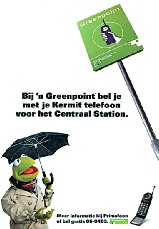
Situation of transmitter locations after the third Dutch transmitter in the south was replaced by the Belgian transmitter in Baraque de Fraiture. This shows the basic transmitter network of the Semafoon 1 system. Four primary transmitters were used: Smilde, which operated at 1 kW effective radiated power (ERP) at 256 meters above sea level; the main Dutch transmitter at Lopik, with 10 kW ERP at 380 meters above sea level; in Belgium, Denderhoutem, with 20 kW ERP at 160 meters above sea level; and Baraque de Fraiture, with 20 kW ERP at 650 meters above sea level. Each transmitter operated sequentially on four frequencies in the 4-meter band. As interference to the German FM broadcast was anticipated, the Dutch transmitters at Smilde and Lopik used special antenna arrays to provide attenuation towards the German border. After the introduction of the MINOR and PICCOLO Semafoon, both equipped with inefficient antennas, a number of auxiliary transmitters had to be installed at locations with unreliable radio coverage. To see the initial transmitter locations, click HERE. For the final situation after the installation of auxiliary low-power transmitters around 1985, click HERE.
MINOR Semafoon.
1971-1990
KOLIBRIE Semafoon (1975-1990)
An Escort Semafoon was installed in a vehicle using a special cradle that allowed the Escort to be taken when leaving the car. On the left-hand side was a control box of the Dutch OLN (Mid-1970s).

